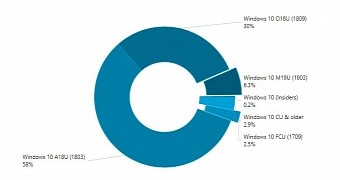New figures provided by AdDuplex reveal that the adoption of Windows 10 May 2019 Update, or version 1903, improves at a really slow pace, but while some could be tempted to believe this is another failed release, this is unlikely to be the case.
AdDuplex data shows that Windows 10 April 2018 Update (version 1803) is currently the leading Windows 10 version on the market with a share of 58%, followed by Windows 10 October 2018 Update (version 1809) with 30%.
Windows 10 May 2019 Update (version 1903) is only third with 6.3%.
“Windows 10 May 2019 Update (1903) has gained around 5% since last month and is now on 6.3% of close to 100,000 PCs surveyed. This puts it on par with the pace of 1809 one month after its re-release. And this is, probably, not a good sign as we've seen how this ended (just over 30% install base before the next release went out),” the AdDuplex report reads.
Cautious rollout of Windows 10 May 2019 Update
While the adoption of the new feature update seems to match the one of the version 1809, the reasons behind the slow migration to the May 2019 Update is likely different from what these figures appear to suggest.
Most users decided to delay the upgrade to Windows 10 October 2018 Update because of the bugs in the update. Microsoft even pulled the update completely after it discovered a glitch which could have caused the complete removal of some user files stored in libraries.
But in the case of the May update, the slow adoption is the result of Microsoft releasing the new version to only a handful of devices, as it wants to make sure that widespread issues are discovered before they hit a more significant number of devices.
The update is pushed in stages to devices via Windows Update, and seekers can get it with a manual check for updates in Windows 10.

 14 DAY TRIAL //
14 DAY TRIAL //